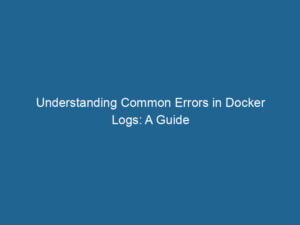
Understanding Common Errors in Docker Logs: A Guide
Docker logs are essential for troubleshooting containerized applications. This guide explores common errors found in Docker logs, helping users identify and resolve issues effectively.
Troubleshooting is an essential skill for managing Docker environments, as it enables developers and operators to diagnose and resolve issues that arise during the development, deployment, and operation of containerized applications. Docker provides several tools and best practices to aid in troubleshooting, ensuring that issues can be identified and addressed quickly and effectively.
One of the primary tools for troubleshooting Docker containers is the docker logs command. This command retrieves the logs of a running or stopped containerContainers are lightweight, portable units that encapsulate software and its dependencies, enabling consistent execution across different environments. They leverage OS-level virtualization for efficiency…., providing valuable insights into the application’s behavior and any errors that may have occurred. By analyzing the logs, users can identify issues related to application crashes, misconfigurations, and other runtime errors. For more advanced log management, Docker can be integrated with centralized logging solutions like the ELK StackA stack is a data structure that operates on a Last In, First Out (LIFO) principle, where the most recently added element is the first to be removed. It supports two primary operations: push and pop…., allowing for comprehensive log analysis and visualization.
The docker inspect command is another powerful tool for troubleshooting. It provides detailed information about Docker objects, such as containers, images, volumes, and networks. By running docker inspect <object>, users can view the configuration, state, and runtime information of a Docker object, helping to identify issues related to resource limits, environment variables, and networkA network, in computing, refers to a collection of interconnected devices that communicate and share resources. It enables data exchange, facilitates collaboration, and enhances operational efficiency…. settings. This command is particularly useful for verifying the correctness of configurations and understanding the internal state of Docker objects.
For real-time monitoring of container performance, the docker stats command displays resource usage metrics such as CPU, memory, network, and disk I/O. This information helps users identify resource bottlenecks and optimize container performance. By monitoring these metrics, users can detect issues like high CPU usage, memory leaks, and excessive disk I/O, allowing them to take corrective actions promptly.
Network issues can be diagnosed using the docker networkDocker Network enables seamless communication between containers in isolated environments. It supports various drivers, such as bridge and overlay, allowing flexible networking configurations tailored to application needs.... command suite. The docker network ls command lists all available networks, while docker network inspectDocker Network Inspect provides detailed insights into a Docker network's configuration and connected containers. This command is essential for troubleshooting network issues and optimizing container communication.... <network> provides detailed information about a specific network. Additionally, the docker network connectDocker Network Connect enables containers to communicate across different networks. It allows for seamless integration and management of network configurations, enhancing application deployment flexibility.... and docker network disconnectDocker's network disconnect feature allows users to isolate containers from specific networks, enhancing security and resource management. This command is vital for maintaining efficient container communications.... commands allow users to manage container network connections. Tools like ping and curl can be used within containers to test network connectivity and diagnose issues related to DNS resolution, routing, and firewall rules.
Debugging misbehaving containers often involves accessing the container’s shell. The docker exec command allows users to run“RUN” refers to a command in various programming languages and operating systems to execute a specified program or script. It initiates processes, providing a controlled environment for task execution…. commands inside a running container, providing an interactive shell for troubleshooting. By running docker exec -it <container> /bin/bash or docker exec -it <container> /bin/sh, users can inspect the container’s filesystem, check running processes, and modify configurations on the fly. This command is invaluable for diagnosing application-level issues and making temporary fixes.
When containers fail to start or behave unexpectedly, examining the Docker daemonA daemon is a background process in computing that runs autonomously, performing tasks without user intervention. It typically handles system or application-level functions, enhancing efficiency…. logs can provide additional insights. These logs are typically located in /var/log/docker.log on Linux systems. By reviewing the daemon logs, users can identify issues related to Docker’s runtime environment, such as storage driver problems, network errors, and daemon configuration issues.
Container imageAn image is a visual representation of an object or scene, typically composed of pixels in digital formats. It can convey information, evoke emotions, and facilitate communication across various media…. issues can be diagnosed using the docker image command suite. The docker image ls"Docker Image LS" is a command that lists all Docker images on a system. It provides key details such as image IDs, repository names, tags, and sizes, aiding in efficient image management and organization.... command lists all available images, while docker image inspectDocker Image Inspect is a command-line tool that retrieves detailed metadata about Docker images. It provides insights into layers, configuration, and environment variables, essential for optimizing container deployments.... <image> provides detailed information about a specific image. Additionally, the docker history <image> command displays the history of an image, showing the layers and commands used to build it. This information helps users identify issues related to image creation, such as missing dependencies, incorrect build commands, and large image sizes.
Lastly, Docker provides integration with various third-party tools and services that enhance troubleshooting capabilities. Monitoring and alerting tools like Prometheus, Grafana, and Datadog provide real-time insights into container performance and health, enabling proactive issue detection and resolution. These tools can be configured to collect and visualize metrics, set up alerts for specific conditions, and provide historical data for trend analysis.
In summary, effective troubleshooting in Docker involves using built-in commands like docker logs, docker inspect, docker stats, and docker exec, as well as integrating with third-party tools for advanced monitoring and logging. By leveraging these tools and following best practices, users can quickly diagnose and resolve issues, ensuring the reliability and performance of their containerized applications.

Docker logs are essential for troubleshooting containerized applications. This guide explores common errors found in Docker logs, helping users identify and resolve issues effectively.
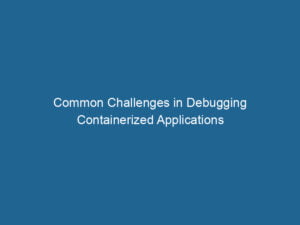
Debugging containerized applications presents unique challenges, including handling ephemeral environments, managing dependencies, and ensuring consistent logging across distributed systems. Understanding these issues is crucial for effective troubleshooting.
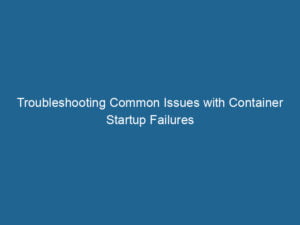
ContainerContainers are lightweight, portable units that encapsulate software and its dependencies, enabling consistent execution across different environments. They leverage OS-level virtualization for efficiency.... startup failures can arise from various issues, such as misconfigured settings, insufficient resources, or networkA network, in computing, refers to a collection of interconnected devices that communicate and share resources. It enables data exchange, facilitates collaboration, and enhances operational efficiency.... conflicts. Identifying logs and error messages is crucial for effective troubleshooting.
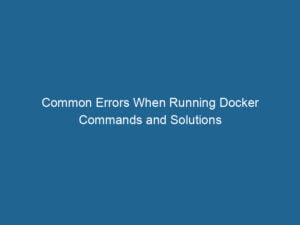
When using Docker, common errors include issues with imageAn image is a visual representation of an object or scene, typically composed of pixels in digital formats. It can convey information, evoke emotions, and facilitate communication across various media.... pulling, containerContainers are lightweight, portable units that encapsulate software and its dependencies, enabling consistent execution across different environments. They leverage OS-level virtualization for efficiency.... starting, and networkA network, in computing, refers to a collection of interconnected devices that communicate and share resources. It enables data exchange, facilitates collaboration, and enhances operational efficiency.... configuration. Solutions often involve checking command syntax, ensuring proper permissions, and verifying network settings.
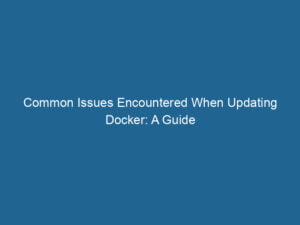
Updating Docker can lead to several common issues, including compatibility problems, configuration changes, and performance regressions. This guide explores these challenges and offers solutions.
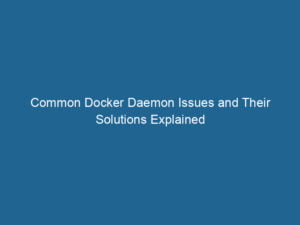
Docker daemonA daemon is a background process in computing that runs autonomously, performing tasks without user intervention. It typically handles system or application-level functions, enhancing efficiency.... issues can hinder containerContainers are lightweight, portable units that encapsulate software and its dependencies, enabling consistent execution across different environments. They leverage OS-level virtualization for efficiency.... management. Common problems include serviceService refers to the act of providing assistance or support to fulfill specific needs or requirements. In various domains, it encompasses customer service, technical support, and professional services, emphasizing efficiency and user satisfaction.... failures, networking errors, and permission issues. Solutions often involve checking logs, updating configurations, or adjusting permissions.
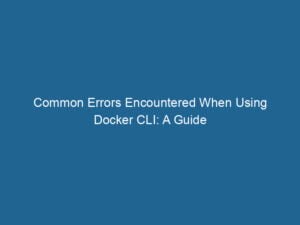
When using Docker CLI, users often encounter common errors such as imageAn image is a visual representation of an object or scene, typically composed of pixels in digital formats. It can convey information, evoke emotions, and facilitate communication across various media.... not found, permission denied, and networkA network, in computing, refers to a collection of interconnected devices that communicate and share resources. It enables data exchange, facilitates collaboration, and enhances operational efficiency.... issues. Understanding these pitfalls can enhance efficiency and streamline containerContainers are lightweight, portable units that encapsulate software and its dependencies, enabling consistent execution across different environments. They leverage OS-level virtualization for efficiency.... management.
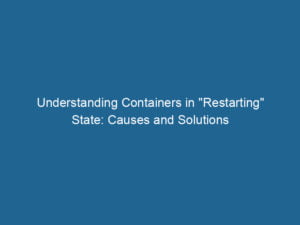
In containerized environments, a “Restarting” state often indicates issues such as resource constraints, misconfigurations, or application errors. Identifying the root cause is essential for effective resolution.
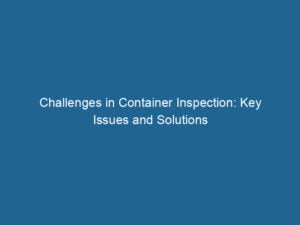
ContainerContainers are lightweight, portable units that encapsulate software and its dependencies, enabling consistent execution across different environments. They leverage OS-level virtualization for efficiency.... inspection faces challenges such as inconsistent standards, limited technology, and human error. Solutions include enhanced training, automation, and standardized procedures to improve accuracy and efficiency.
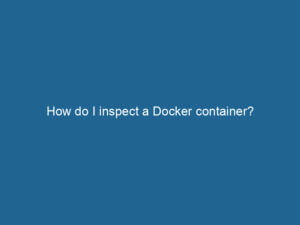
To inspect a Docker containerContainers are lightweight, portable units that encapsulate software and its dependencies, enabling consistent execution across different environments. They leverage OS-level virtualization for efficiency...., use the command `docker inspect `. This provides detailed information about the container’s configuration and state.

DockerPros is the premier online destination for all things Docker. Whether you’re a seasoned developer or just starting your journey with containerization, our site offers comprehensive resources to help you master Docker and elevate your DevOps skills.
Copyright © 2025. All rights reserved.